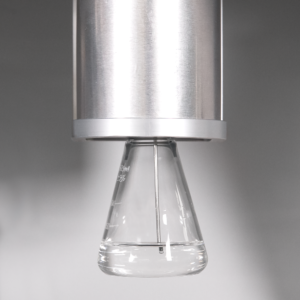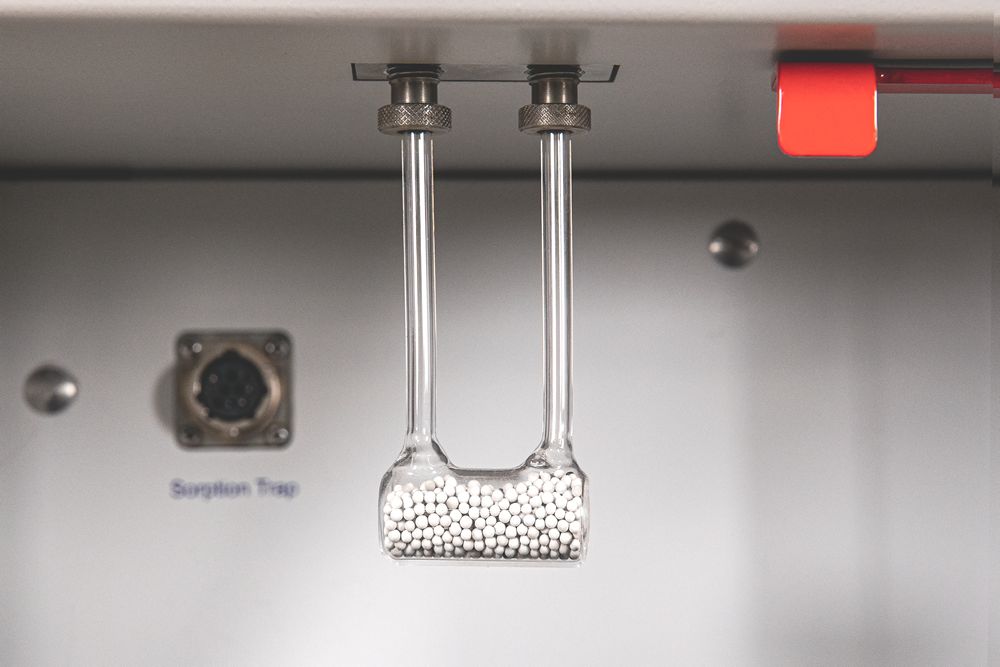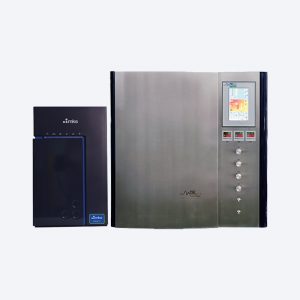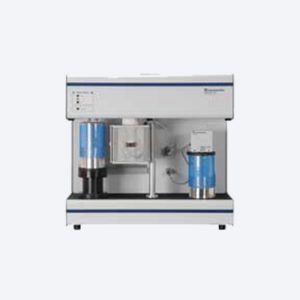Description
The AutoChem from Micromeritics is the most widely used and highly cited system for catalyst reactivity characterization because it is also the most automated, highly accurate system for chemisorption and temperature-programmed reactions.
The all new AutoChem III meets and exceeds that performance with a design that will save you hours a day, make the most sensitive, reproducible measurement, and enhance operator safety.
Benefits
Quick & Easy
The new AutoChem III is designed to make key operations quick and easy, saving you hours a day so you can spend less time making measurements and more time making progress.
RAPID TURNAROUND TIME WITH AUTOCOOL

The NEW AutoCool is an integrated gas-fed system that rapidly cools sample tubes before and during experiments. AutoCool is typically 30 minutes faster than alternative systems and requires no liquids or external support.
NEVER PREPARE ANOTHER VAPOR CAPTURE SLUSH BATH

The NEW AutoCool is an integrated gas-fed system that rapidly cools sample tubes before and during experiments. AutoCool is typically 30 minutes faster than alternative systems and requires no liquids or external support. The NEW AutoTrap effectively traps vapor and requires no manual slush bath preparation.
Traditional methods for vapor capture require the time-intensive process of slush-bath preparation through the manual mixing of liquid nitrogen with isopropanol. The zeolite bed of the AutoTrap effectively captures vapors, can be used for several experiments without interruption and can be regenerated in situ.
PROGRAM WHAT YOU ENVISION, VISUALIZE WHAT YOU HAVE PROGRAMMED

The new MicroActive method editor features an intuitive process illustration that shows the programmed state of the instrument at every step of the method so you can see that your method matches your vision.
MAKING ACCURACY EASY:
EXCLUSIVE AUTOMATED DETECTOR CALIBRATION
The AutoChem III makes quantitative accuracy simple with automated detector calibration. Traditional systems require calibration by multiple runs of reference materials or single-point offsets that ignore changes in temperature or pressure.
The AutoChem III generates accurate results through a fully automated process using the system’s patented gas blending capabilities including compensation for injection loop temperature and pressure to ensure the highest calibration – and result – accuracy. The process is fast, automated, requires no operator intervention, and produces more accurate results than alternative designs.
US Pat #10,487,954 B2
LOADING SAMPLE IS A SNAP

The patented new KwikConnect makes sample tube installation faster, easier, and more reliable than traditional designs with half as many separate pieces and no threaded fittings. Installation and removal are easier and quicker, reduce the risk of breaking sample tubes, and provide peace of mind that the snap lock closure has completely sealed the system.
US PAT #11,105,825 B2
READY TO RUN WITH 18 AVAILABLE GAS STREAMS

Don’t waste time reconnecting and switching gas lines: have what you need ready when you need it. The AutoChem III has 18 available gas streams so you’re always ready to run your next reaction. Having the right blended gas ready also means you won’t introduce errors from poorly designed external gas connections, and you won’t compromise data accuracy by blending gases, which unnecessarily introduces errors from mass flow controllers.
Better Measurements for more Confident Decisions
The AutoChem III provides results that drive confident decisions. The highest available measurement accuracy and repeatability – made under conditions that match your reaction environment – give you certainty to act with confidence.
PRECISION TEMPERATURE CONTROL
Exacting thermal accuracy is essential to simulate reaction conditions while preventing the deactivation of precious catalyst materials. The AutoChem III exceeds all available systems in every key performance characteristic
- Widest range of temperatures: -100°C to 1200°C
- Widest range of heating rates: 0.1 °C/min to 100 °C/min
- Repeatable temperature profiles
- Accurate determination of activation energy, Ea
- Local sample temperature measurement
- Superior control accuracy without overshoots
- Four independently controlled gas stream temperature zones eliminate vapor condensation and enhance measurement stability
MOST ACCURATE GAS STREAM COMPOSITION
The AutoChem III features the lowest gas flow path volume to eliminate carryover and signal tailing when changing gas flow conditions. This guarantees precise gas stream composition, even when switching configurations from one experiment to another.
And with 18 available gas inlets, you will have the gas composition that you need ready, without introducing errors associated with blending gases in situ.
BETTER TEMPERATURE CONTROL AT EVERY STEP
- FURNACE: to simulate reaction conditions
- VAPOR: to control vapor composition
- GAS STREAM: to maximize detection sensitivity
- DETECTOR: to ensure robustness
SEE MORE OF YOUR REACTION WITH THE MOST SENSITIVE CHEMISORPTION SYSTEM IN THE WORLD
The new AutoChem III features a new thermal conductivity detector (TCD) that is 110% more sensitive than previous designs. This enables you to use lower sample masses, accurately detect secondary reactions, and achieve greater accuracy of catalyst traits like site coverage.
Detector sensitivity is enhanced by a reference stream with a dedicated mass flow controller (MFC) that provides a stable reference to the sample stream. Alternative designs use a common carrier stream for both the reference and signal paths, resulting in interference between the measurement and reference stream leading to signal instability.
The temperature-controlled TCD is a robust sensor with a long operating life and intrinsic protection from operational errors like gas flow leaks that cause premature failure of 4-element detectors used in inferior designs.

CONTINUOUS CONTROLLED VAPOR DOSING
Achieve faster analysis and more complete characterization of surface selectivity and functionality with the available vapor generator featuring automated vapor calibration, injection repeatability better than 1%, and all new continuous dosing capabilities.
This system creates uniform streams of saturated vapors such as water, alcohols, amines, or organics that are used to prepare samples for TPD or as the reaction gas stream.
The new continuous dosing capability enables faster and more uniform vapor dosing than legacy systems that are limited to discrete vapor stream pulses.
MOVE QUICKLY FROM DATA TO DECISION
Rapidly transition from experimental data to material characteristics with Micromeritics’ own AutoChem data analysis software. Get all the answers you need with:
- Interactive peak analysis including limit selection, baseline definition, integration, and deconvolution
- Built-in analysis models for pulse chemisorption, % dispersion, metal surface area, crystallite size, First-order kinetics, heat of desorption, activation energy, BET, Langmuir, total pore volume, and more.
- Seamless integration of mass spec data
- Detailed, configurable graphical reports


Improving Operator Safety
The AutoChem III enhances operator safety at every stage of the measurement, reducing opportunities for exposure and potential for hazardous conditions.
NO CRYOGENIC LIQUIDS
The new AutoTrap removes moisture without cryogenic liquids such as liquid nitrogen. The AutoTrap also eliminates the need for slush bath preparation, which requires vigorous mixing of alcohols and other solvents in glass vacuum flasks.
COOL TO THE TOUCH THIRD-PARTY TESTED AND VERIFIED
The new AutoCool brings sample tubes to room temperature so fast after every experiment that you can change samples and start the next experiment quickly, without handling hot glass sample tubes. And the KwikConnect sample tube retention system allows you to release the tube in one motion without fumbling with threaded connections and separate adapter pieces.
THIRD-PARTY TESTED AND VERIFIED
Micromeritics products are third-party-tested to conform to the highest level of regulatory compliance and operational safety. Install and run with the confidence that the system will meet or exceed requirements for electrical safety and compatibility with the need for separate qualifications or assessments.










